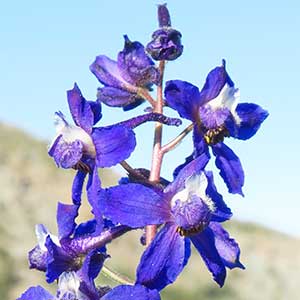Delphinium glareosum
Delphinium polycladon
Olympic larkspur, Olympic Mountain larkspur, rockslide larkspur
high mountain larkspur, mountain marsh larkspur
20-40 cm;
base reddish or not, glabrous, glaucous.
(20-)60-100(-160) cm;
base reddish or not, glabrous.
blade round, 2-4 × 3-7 cm, not succulent, glabrous; ultimate lobes 7-15, width 3-10 mm (basal), 2-7 mm (cauline).
blade round to pentagonal, 1.5-7 × 2-14 cm, glabrous; ultimate lobes 3-12, width 4-30(-45) mm (basal), 3-30 mm (cauline).
5-12-flowered;
pedicel 1-5(-10) cm, nearly glabrous to glandular-puberulent;
bracteoles 2-10(-20) mm from flowers, green, linear, 3-8 mm, puberulent.
3-15(-35)-flowered, open, often ± secund;
pedicel 1-4(-15) cm, glabrous to puberulent;
bracteoles 2-8(-37) mm from flowers, green, linear, 4-7(-11) mm, nearly glabrous.
sepals dark blue, nearly glabrous, lateral sepals spreading, 14-22 × 6-10 mm, spurs ± straight, orientation varies from 30° above to 30° below horizontal, 16-20 mm;
lower petal blades slightly elevated, ± covering stamens, 6-9 mm, clefts 2-4 mm;
hairs local, densest on inner lobes near base of cleft, white to light yellow.
sepals bluish purple, nearly glabrous, lateral sepals spreading, (10-)12-18 × 7-10 mm, spurs usually downcurved, ca. 30° below horizontal, 11-22 mm;
lower petal blades slightly elevated, ± exposing stamens, 4-6 mm, clefts 1-2 mm;
hairs mostly near base of cleft on inner lobes, yellow, sometimes white.
12-17 mm, 2.5-3 times longer than wide, glabrous.
13-20 mm, 3.5-4 times longer than wide, puberulent.
± wing-margined;
seed coat cells with surfaces smooth.
unwinged;
seed coat cells with surfaces roughened.
= 16.
Delphinium glareosum
Delphinium polycladon
See discussion under Delphinium bicolor.
(Discussion copyrighted by Flora of North America; reprinted with permission.)
Delphinium polycladon hybridizes with D. depauperatum and D. glaucum. Plants of D. polycladon are extremely variable. Individuals from very rocky, thin-soiled, sunny sites at higher elevations tend to be quite compact; they show the features of the species in a dwarfed state. Proximal internodes are especially shortened. Plants from areas of deeper soil (high or low elevations), especially those growing among shrubs, usually are much taller, with elongate proximal internodes, and other vegetative parts proportionally larger. Shorter plants may be confused with D. depauperatum or D. nuttallianum; see discussion under those species for distinguishing features. Taller plants may be confused with D. glaucum; they can be distinguished by their leaves predominately on proximal part of stem, sigmoid pedicel, and fewer flowers.
(Discussion copyrighted by Flora of North America; reprinted with permission.)


